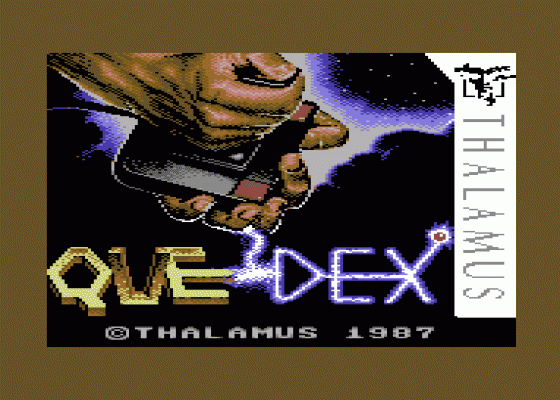Quedex
Stavros Fasoulas' third program isn't, as one might expect, a horizontally scrolling shoot-'em-up. No, Quedex is a far departure from those, and involves absolutely no shooting at all - but plenty of scrolling in all directions.
The game revolves around the player's attempts to guide a metal ball across a small landscape or 'plane' to the 'goal area' (effectively the exit) within an alloted time. This task is made considerably more difficult by the addition of hazards and features which must be negotiated successfully.
There are ten planes - each has an individual decor and requires a different playing approach. They may be played in any sequence, either by setting the order of play beforehand or by simply accessing each plane from the numeric keys 1-0. If the current plane is proving too difficult, another may be started, again simply by the press of a numbered key.

For the inquisitive, a brief resume of the ten planes follow:
Plane 1: Consists of a set of five sub-planes each with simple aims that allow the player to recognise features and practise the style of control used throughout the other planes. This plane becomes increasingly difficult to complete if attempted later in the game.
Plane 2: A multi-directionally scrolling maze is negotiated using teleport pads and by collecting keys to open doorways.

Plane 3: Find the four hidden amulets to make the 'goal' appear. Teleports, deadly electric seas and hidden walls appear in abundance to disorientate and confuse!
Plane 4: A downhill race against the clock, with movement being restricted to right and left. Avoid the electric seas and blocks, collision with which removes vital seconds from the timer.
Plane 5: Moving the ball from tile to tile alters their colour from patterned to plain and vice versa. The plane is completed only when all the available tiles are patterned.

Plane 6: Collect the visible tokens for extra jumps and the invisible tokens for unknown effects. Negotiate the plane by riding through pipes and avoiding skulls - which prematurely end the game.
Plane 7: Unlike the other planes, once entered this one must be completed before leaving. The player guides the ball around pathways, collecting extra time units. Failing to keep to the path means that the ball touches the goal surface and leaves the plane - and wastes precious seconds!
Plane 8: A really swift one, this. Collect the four keys to open one of the doors to the goal. Speed is of the essence since the floor dissolves rather quickly...
Plane 9: One for those with destructive tendencies. Collect crosses to gain extra speed. The ball turns blue and can destroy blocks which bar the way.
Plane 10: Negotiate a series of suspended stepping stones to reach the goal. Plinths of differing grey shades hang at varying heights, and jumping from one to another can only be accomplished safely if the height difference is one unit. Reach the goal as quickly as possible, but be wary of conveyor belts and the all-pervading chasm!
After the successful completion of a plane, a bonus plane appears taking the form of a 'Simon' game. Several directions are displayed from a central square and the player repeats them using the joystick, guiding the ball to the required square. Achieving this is rewarded with a suitable bonus score.
CB
I never realised how bad I was at using a joystick until I played this one - some of the levels are so difficult! What am I talking about? I couldn't even negotiate the practice level with any degree of competence.
Stavros has also managed to instill some of his own quirkly humour in the gameplay - like a level where you have to search for hidden keys which will only open specific doors... aaaargh! I'm a long way off from ultimate dexterity, I think, but maybe with a little more practice...
SJ
As with the two previous Thalamus games, the presentation here is superb - the silky smooth scrolling, gorgeous graphics and clever touches put this head and shoulders above most of the rest of mainstream software.
Almost every plane is a delight to watch and play, and not one of them looks as it it was an afterthought. My personal favourites are plane six for graphics (ridiculously good) and plane nine because I can finish it!
You may well buy several games this month, but I think you'll be playing Quedex long after all the others have been relegated to the cupboard. I'd already like to see a Quedex II - or the ability to load different planes into this one. How about it, Thalamus?
JR
A word of warning: Make sure that you've got a couple of spare hours before you embark on the quest for ultimate dexterity. From the very first go, Quedex grabs you by the joystick and doesn't let go - it's one of those infuriating addictive games that demands constant attention.
The graphics are gorgeous, the gameplay truly dextral and presentation first-class.
The thought that has gone into the game's design is admirable - Quedex is beautifully designed, highly original and wholeheartedly recommended to anyone who thinks they can stand the pace!
Verdict
Presentation 95%
Superb. Includes an informative demo and plenty of thoughtful user-friendly touches.
Graphics 94%
The use of colour and shading is second-to-none, and the end result has tremendous depth and feel.
Sound 79%
A decent title tune blasts out, and the sound effects are more than adequate.
Hookability 92%
As soon as you pick up the joystick, a challenge is laid down which is not easily ignored.
Lastability 87%
The ten planes should provide most potential purchasers with a new pastime for the months ahead.
Overall 92%
An original, beautifully designed and superbly implemented puzzle package.


 1st November 1987
1st November 1987

